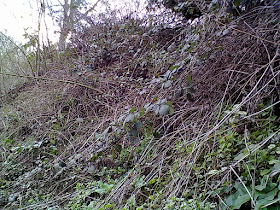One of my clients very kindly saves the gardening section of the Telegraph for me each week, and I find it very useful for keeping up with what is current, in the eyes of the general public.
Last week's one has a feature on Joe Swift, freshly recovered from his first (and last, he says!) appearance at Chelsea as a competitor, rather than a commentator.
Now, I have a qualification in garden design, but I never, ever call myself a garden designer: prior to reading Joe's comment, I would have said for two reasons, but now I shall add his reason to my list.
His reason? He made the following comment:
"I haven't gone down the garden-designing route because the people with enough money to let you do a proper garden tend to be very controlling."
(If you want to read the article, it's
here.)
How very perceptive!
I've observed this phenomenon myself, as in the past I've worked with a couple of local garden designers, and I have had to listen to them on the subject: and yes, clients have their own ideas about what they want, and so, it seems, do the designers. Well, of course they do, otherwise they wouldn't be designers, would they?
It's always funny being piggy-in-the-middle: on one particular morning, after hearing the designer (who I knew well) expressing herself freely on what she wanted to do, but would not be allowed to do, I then had to listen to my client expressing herself equally freely on the iniquities of garden designers who are paid to do what the client wants, but who try to insist on installations that are not at all in line with what the client requires, and who are clearly "not listening".
On balance, I think I'll stick to being a gardener, with a willingness to make suggestions if required!
Oh, and in case you're interested, my other two reasons?
Firstly, garden design involves an awful lot of non-gardening work: there are client meetings, briefing sessions, measuring sessions: the first draft includes hours spent checking suitability of plant sizes and spread, and hours spent actually creating the plan, either by hand or on the computer: then there's the presentation of the design, discussion with client, amendments to plan, more hours spent checking on suitability of other plants to replace any the client didn't like the sound of: re-presentation, acceptance of plan, relief all round, and so on.
This is why "proper" garden designers charge thousands of pounds: they have to cover all that time and effort.
Personally I prefer actually getting my hands dirty.
Second reason: I have done quite a lot of small-scale garden re-designs, usually for a newly cleared area, or to completely revamp a tired section - as opposed to cohesive design of an entire garden - and I keep running up against this same problem:
If I supply a list of plants, the client will never, ever, buy exactly what I specify. They smile and say "oh, those ones were really expensive so instead of getting five, I got two, and they didn't have those ones, so I got those instead."
Thus instead of co-ordination of colour and height, and a decent coverage of the ground, we end up with a skimpy show of bits and pieces, some of which are completely inappropriate for the soil, or for the design. Or both. And it doesn't reflect well upon me.
So I end up specifying a budget, getting that approved, and then having to go and do the plant shopping myself. Which takes a massive amount of time, for which I don't get paid. Grr!
There is also another element to this second reason *looks around guiltily in case anyone is listening* in that I propagate and sell plants (shameless plug: go to
Dews Meadow Farm Shop, folks, on the A338 just north of Wantage, where I have a permanent sales bench) and there is always a tendency to favour my own plants when I design a bed.....
In my opinion, there is a world of difference between "getting in a garden designer" and "asking my gardener to redesign that area" and I now make sure that if a client asks about re-designing, they understand the difference.
Garden designer = thousands of pounds, style, instant effect, job-in-a-box.
Gardener designing = cheap, gradual effect, constantly evolving.
What do you think?






